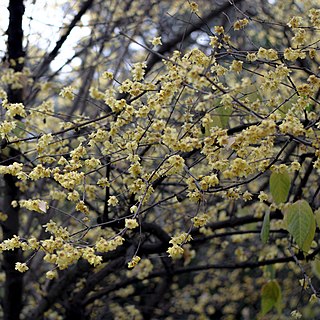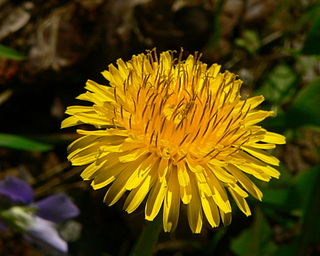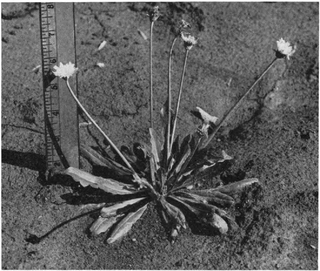
Anemonoides nemorosa, the wood anemone, is an early-spring flowering plant in the buttercup family Ranunculaceae, native to Europe. Other common names include windflower, European thimbleweed, and smell fox, an allusion to the musky smell of the leaves. It is a perennial herbaceous plant growing 5–15 cm (2–6 in) tall.

Lotus corniculatus is a flowering plant in the pea family Fabaceae, native to grasslands in temperate Eurasia and North Africa. Common names include common bird's-foot trefoil, eggs and bacon, birdsfoot deervetch, and just bird's-foot trefoil, though the latter name is often also applied to other members of the genus.

Chimonanthus is a genus of flowering plants in the family Calycanthaceae, native to China, but is also cultivated elsewhere in Asia, including Iran. The genus includes three to six species depending on taxonomic interpretation; six are accepted by the Flora of China. The name means winter flower in Greek.

Spergula arvensis, the corn spurry, stickwort, starwort or spurrey, is a species of plant in the genus Spergula.

Allium validum is a species of flowering plant commonly called swamp onion, wild onion, Pacific onion, or Pacific mountain onion. It is native to the Cascade Range, to the Sierra Nevada, the Rocky Mountains, and other high-elevation regions in California, Oregon, Washington, Nevada, Idaho and British Columbia. It is a perennial herb and grows in swampy meadows at medium and high elevations.

Cunila origanoides, with the common names stone mint, frost mint, dittany, and American dittany, is a perennial late-summer-flowering subshrub with small purple flowers that is native to the central and eastern United States. It belongs to the Lamiaceae (mint) family and is the only species in the Cunila genus native to the United States. It grows in habitats such as dry forests and the thin soil around rock outcrops. This species has historically been cultivated for use as a medicinal herb, tea, and ornamental plant.

Bolax is a genus of flowering plant in the family Apiaceae. Two species are currently accepted by Plants of the World Online. It is endemic to temperate South America.

Taraxacum officinale, the dandelion or commondandelion, is a herbaceous perennial flowering plant in the daisy family Asteraceae. The common dandelion is well known for its yellow flower heads that turn into round balls of many silver-tufted fruits that disperse in the wind. These balls are called "clocks" in both British and American English. The name "blowball" is also used.

Latex is an emulsion of polymer microparticles in water. Latexes are found in nature, but synthetic latexes are common as well.

Taraxacum is a large genus of flowering plants in the family Asteraceae, which consists of species commonly known as dandelions. The scientific and hobby study of the genus is known as taraxacology. The genus is native to Eurasia and North America, but the two most commonplace species worldwide, T. officinale and T. erythrospermum, were introduced from Europe into North America, where they now propagate as wildflowers. The plant thrives in temperate regions and can be found in yards, gardens, sides of roads, among crops, and in many other habitats. Both species are edible in their entirety. The common name dandelion is also given to specific members of the genus.

Hyssopus officinalis or hyssop is a shrub in the Lamiaceae or mint family native to Southern Europe, the Middle East, and the region surrounding the Caspian Sea. Due to its purported properties as an antiseptic, cough reliever, and expectorant, it has been used in traditional herbal medicine.

Cruciata laevipes is a species of flowering plant in the family Rubiaceae. It is commonly known as crosswort, smooth bedstraw or Luc na croise in Gaelic. The Latin epithet laevipes refers to the smooth stalk.

Taraxacum kok-saghyz, often abbreviated as TKS and commonly referred to as the Kazakh dandelion, rubber root, or Russian dandelion, is a species of dandelion native to Kazakhstan, Kyrgyzstan and Uzbekistan, notable for its production of high-quality rubber. T. kok-saghyz was discovered in Kazakhstan in 1932 by Soviet scientists seeking a domestic source of rubber.

Aphananthe aspera, commonly known as scabrous aphananthe or muku tree, is a flowering plant in the family Cannabaceae. It is found on slopes and stream banks between 100 and 1600 m. It is native to China, Taiwan, Japan, Korea, and Vietnam.

Taraxacum platycarpum, also called the Korean dandelion, is a species of dandelion that grows in Korea. A member of the Cichorieae tribe of the Asteraceae, it also grows in other countries as a native plant, such as China and Japan.

Takhtajaniantha tau-saghyz is a species of plant in the family Asteraceae.
Yevgenia Georgievna Pobedimova (1898-1973) was a Russian-Soviet botanist and plant collector noted for describing over 270 species in Russia, Ukraine and North Asia.
Taraxacum desertorum is a species of flowering plant in the family Asteraceae. It is called the desert dandelion. This species can be found in Azerbaijan and throughout the Caucasus.
Abutilon × milleri, also known as Miller abutilon, is a hybrid species, the result of cross of A. megapotamicum and possibly A. pictum, in the family Malvaceae. It is an evergreen species of flowering plant. It has gained the Royal Horticultural Society's Award of Garden Merit as an ornamental.

Satureja spicigera, the creeping savory, is a species of flowering plant in the family Lamiaceae. It is native to northeastern Turkey, the Caucasus, and northwestern Iran. A perennial prostrate shrub, hardy in USDA zones 6 through 9, it is recommended as an edging plant for rock and herb gardens. Used as a culinary herb, both fresh and dried, its flavor is similar to winter savory, Satureja montana, as it is stronger than summer savory, Satureja hortensis.

















